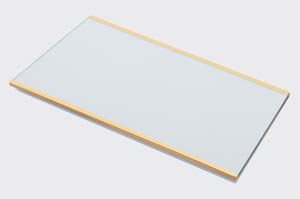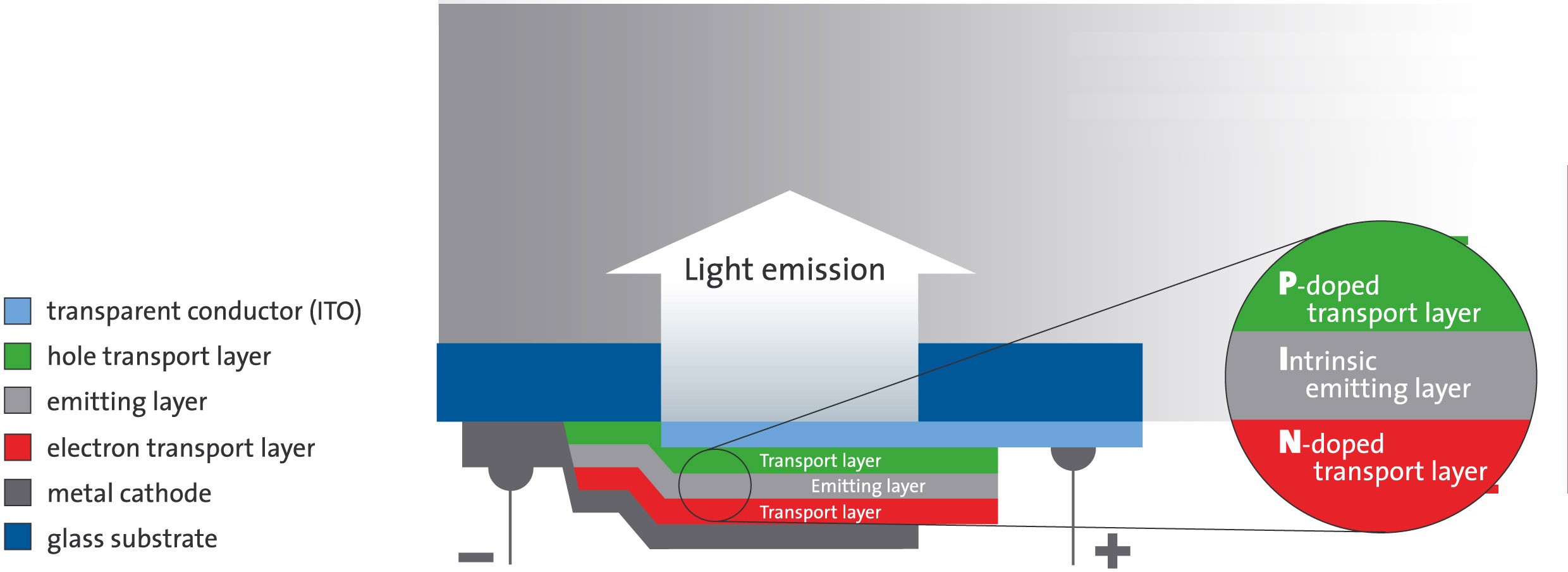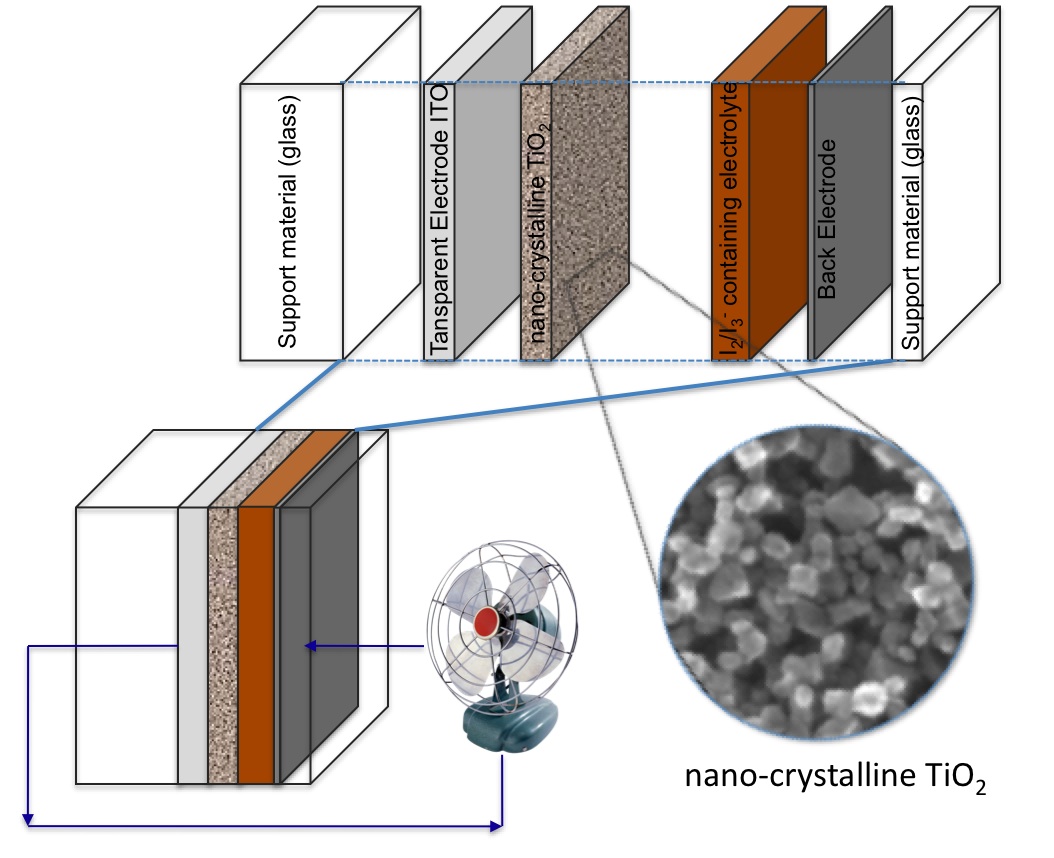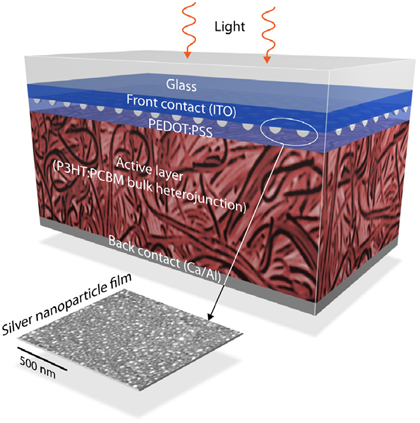Indium tin oxide (ITO, or tin-doped indium oxide) is a solid solution of indium(III) oxide (In2O3) and tin(IV) oxide (SnO2), typically 90% In2O3, 10% SnO2 by weight.
 Indium Tin Oxide
Indium Tin Oxide
As with all transparent conducting films, a compromise must be made between conductivity and transparency, since increasing the thickness and increasing the concentration of charge carriers will increase the material’s conductivity, but decrease its transparency.
 In an organic light-emitting diode (OLED), holes and electrons are injected into a stack of organic layers, which are usually sandwiched between a transparent indium tin oxide (ITO) electrode and a metal electrode. Electrons and holes recombine in the emission zone of the device, which contains organic emitter dyes. Here, excitons are formed by the combining charge carriers, which eventually decay and emit as visible light.
In an organic light-emitting diode (OLED), holes and electrons are injected into a stack of organic layers, which are usually sandwiched between a transparent indium tin oxide (ITO) electrode and a metal electrode. Electrons and holes recombine in the emission zone of the device, which contains organic emitter dyes. Here, excitons are formed by the combining charge carriers, which eventually decay and emit as visible light.
Thin films of indium tin oxide are most commonly deposited on surfaces by electron beam evaporation, physical vapor deposition, or a range of sputter deposition techniques.
ITO is mainly used to make transparent conductive coatings for liquid crystal displays, flat panel displays, plasma displays, touch panels, electronic ink applications, organic light-emitting diodes, solar cells, antistatic coatings and EMI shieldings. In organic light-emitting diodes, ITO is used as the anode (hole injection layer).
 Indium Tin Oxide at Solar Cell Application
Indium Tin Oxide at Solar Cell Application
ITO is also used for various optical coatings, most notably infrared-reflecting coatings (hot mirrors) for architectural, automotive, and sodium vapor lamp glasses. ITO is a heavily-doped n-type semiconductor with a large bandgap. In the ultraviolet, it is opaque because of band-to-band absorption (a UV photon can excite an electron from the valence band to the conduction band).
 Plasmonically enhanced bulk-heterojunction solar cell. Silver nanoparticles are separated from the active layer by a poly(3,4-ethylenedioxythiophene) poly(styrenesulfonate) (PEDOT:PSS) layer. ITO: Indium tin oxide.
Plasmonically enhanced bulk-heterojunction solar cell. Silver nanoparticles are separated from the active layer by a poly(3,4-ethylenedioxythiophene) poly(styrenesulfonate) (PEDOT:PSS) layer. ITO: Indium tin oxide.
Carbon nanotube conductive coatings are a prospective replacement. As another carbon-based alternative, films of graphene are flexible and have been shown to allow 90% transparency with a lower electrical resistance than standard ITO. Thin metal films are also seen as a potential replacement material.
Inherently conductive polymers (ICPs) are also being developed for some ITO applications. Other, inorganic alternatives include aluminium, gallium or indium—doped zinc oxide (AZO, GZO or IZO).
The main concern about ITO is the cost. ITO can be priced at several times that of aluminium zinc oxide (AZO). AZO is a common choice of transparent conducting oxide (TCO) because of cost and relatively good optical transmission performance in the solar spectrum.
However, ITO does consistently defeat AZO in almost every performance category including chemical resistance to moisture. The primary advantage of ITO compared to AZO as a transparent conductor for LCDs is that ITO can be precisely etched into fine patterns. AZO cannot be etched as precisely: It is so sensitive to acid that it tends to get over-etched by an acid treatment.
Another benefit of ITO compared to AZO is that if moisture does penetrate, ITO will degrade less than AZO.ITO can be used in nanotechnology to provide a path to a new generation of solar cells.
Solar cells made with these devices have the potential to provide low-cost, ultra-lightweight, and flexible cells with a wide range of applications.
You might also like
| Semiconductor Materials A semiconductor is a substance,... | The Bayer and Hall-Heroult Process Aluminum manufacture is accomplished... | Corrosion Corrosion is the disintegration of an engineered... | What is Diamond? Diamond is less stable than graphite,... |



 Alloy Suppliers
Alloy Suppliers
 Aluminum
Aluminum
 Aluminum Extrusions
Aluminum Extrusions
 Copper-Brass-Bronze
Copper-Brass-Bronze
 Nickel
Nickel
 Magnets
Magnets
 Stainless Steel
Stainless Steel
 Stainless Steel Tubing
Stainless Steel Tubing
 Steel Service Centers
Steel Service Centers
 Titanium
Titanium
 Tungsten
Tungsten
 Wire Rope
Wire Rope